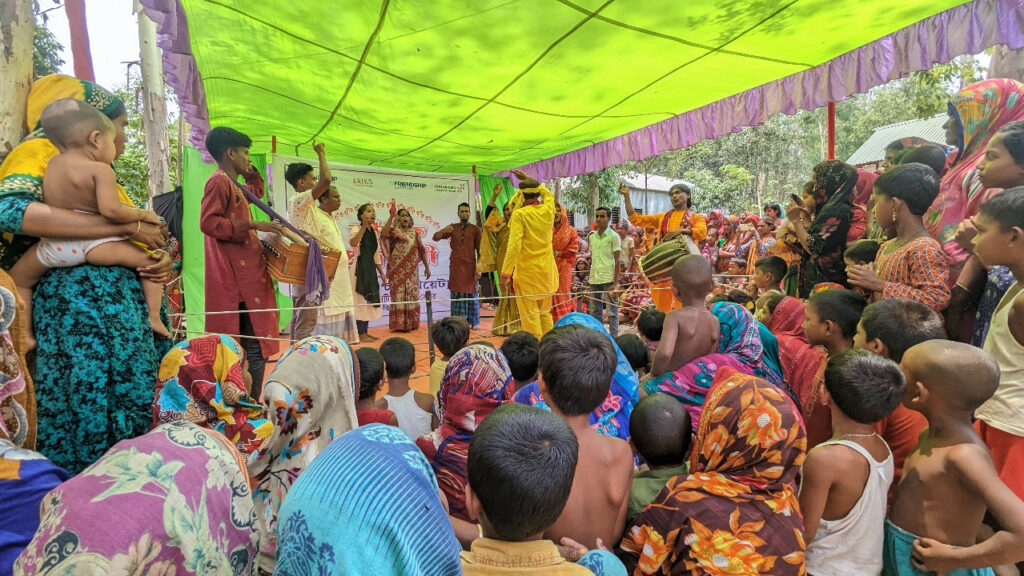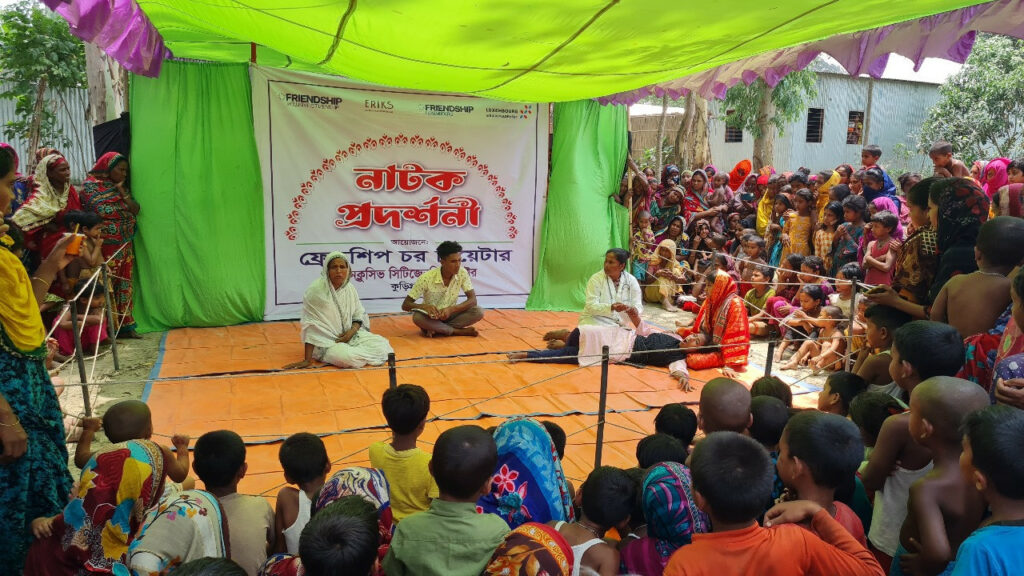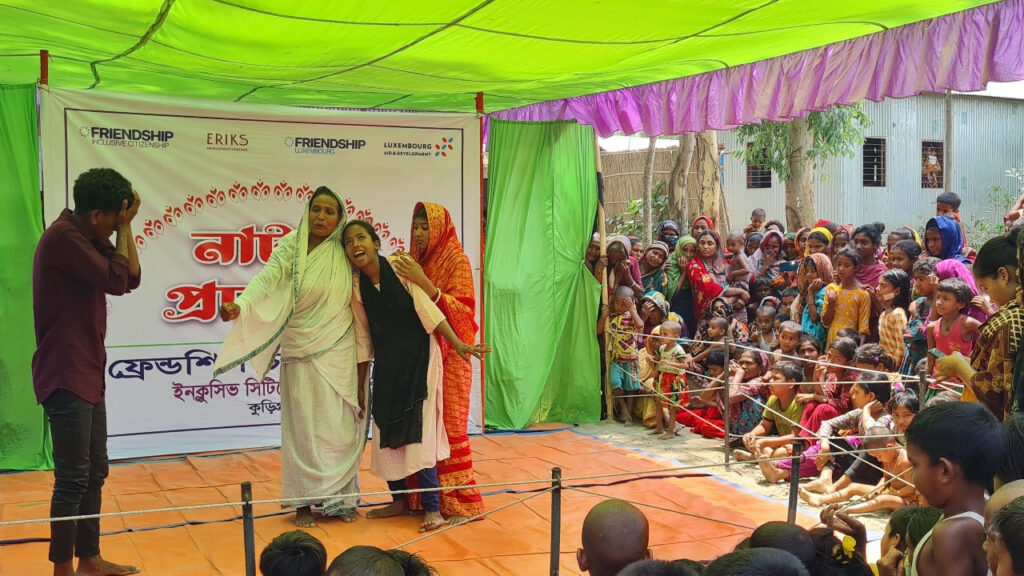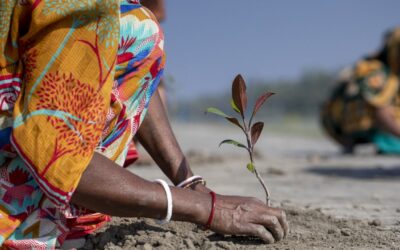A cultural lifeline and catalyst for social change in remote char communities

by Ahmed Toufiqur Rahman,
October 8, 2024
The char lands of northern Bangladesh are a unique landscape, formed by the deposition of sediments carried by rivers like the Brahmaputra, Jamuna, and Teesta. While these constantly shifting sandbanks are fertile, their transient nature and frequent flooding render them unstable for permanent infrastructure development.
Communities living in these chars are forced to endure a nomadic existence, constantly relocating as their homes and fields are swept away by river erosion.
These char regions of northern Bangladesh are known for their geographic remoteness, scattered along shifting river islands that frequently emerge and disappear due to the natural ebb and flow of the rivers. These isolated areas are among the most underdeveloped in the country, largely due to their inaccessibility and vulnerability to environmental changes. Cut off from the mainland for most of the year, the residents of these chars face challenges that extend far beyond the usual socio-economic hardships. The absence of basic infrastructure like roads, electricity, and healthcare facilities has led to persistent underdevelopment, leaving char dwellers struggling with poverty, limited education, and inadequate healthcare.
This geographic instability, combined with a lack of government priority, has resulted in severe underdevelopment. Roads, schools, healthcare facilities, and other basic services are either non-existent or extremely scarce. The few services that do exist are often inaccessible during the monsoon season when the chars are cut off from the mainland. Electricity is a rare commodity, leaving the char residents disconnected from modern sources of information and entertainment such as television, radio, and the internet.
In these remote areas, where traditional media such as television, radio, and even electricity are often absent, theatre becomes more than just a source of entertainment—it is a means of social cohesion, education, and cultural expression. Friendship, a prominent social purpose organization working in these hard-to-reach regions, has introduced Char Theatre as a platform to address the critical social and cultural needs of these isolated communities. The project serves as a bridge to not only entertain but also educate and empower the char dwellers, fostering social change and development through the medium of drama.
As a result, the char dwellers rely on more traditional forms of entertainment and communication, such as oral storytelling and communal events. It is in this context that Char Theatre plays a vital role. With no access to TV or other electronic media, the community gathers to watch the performances, which become a highlight of social life in these isolated areas.
This geographic instability, combined with a lack of government priority, has resulted in severe underdevelopment. Roads, schools, healthcare facilities, and other basic services are either non-existent or extremely scarce. The few services that do exist are often inaccessible during the monsoon season when the chars are cut off from the mainland. Electricity is a rare commodity, leaving the char residents disconnected from modern sources of information and entertainment such as television, radio, and the internet.

In an environment where most modern entertainment options are unavailable, Char Theatre has emerged as a cultural cornerstone for the char communities. The theatre performances are designed to be accessible, educational, and entertaining. With no need for technology or electricity, these live performances are open to everyone in the community, from children to the elderly, allowing them to experience the magic of storytelling and drama in a communal setting.
For many in the chars, the absence of television or cinema means that live theatre is one of the few forms of entertainment available. The performances become a social event, bringing the entire community together, offering not only amusement but also a sense of unity and shared experience. This role of theatre as a primary entertainment source gives it additional significance in the lives of char residents.
Theatre as a medium of communication works particularly well in these regions due to its visual, emotional, and participatory nature. Since literacy rates in the chars are often low, written communication is less effective in spreading awareness. However, drama, by blending visual storytelling with familiar narratives, becomes a tool that can reach everyone, regardless of educational background.
While Theatre offers much-needed entertainment, its real power lies in its potential to drive social change. Just as theatre has historically been used as a revolutionary tool in movements across the world, such as in Latin America and during Bangladesh’s Liberation War, theatres happening in chars addresses the urgent social issues faced by the char communities. The performances tackle topics such as early marriage, domestic violence, healthcare, environmental degradation, and women’s rights, all of which are pressing concerns in the underdeveloped and largely patriarchal societies of the chars.
Char Theatre encourages the audience to participate actively in post-performance discussions. This allows community members to reflect on the issues raised, share their experiences, and collectively brainstorm solutions. In doing so, the char residents are not just passive viewers but are transformed into active participants in their own development, empowered to challenge traditional norms and envision a better future.
A significant strength of Char Theatre is that the performers themselves are local char residents. Unlike external, professional actors, these individuals share the same lived experiences as their audience, making the performances authentic and relatable. This community-driven approach also fosters a sense of ownership and pride among the participants, who not only express their creativity but also become agents of social change within their own communities.
Char Theatre gives a voice to the people of the chars. Through the plays, local actors are able to address the challenges they face—often in their own dialects and through stories that reflect their daily struggles. The theatre thus becomes a space for empowerment, offering an alternative narrative where char dwellers are not just victims of their circumstances but active players in overcoming them.

Char Theatre is also essential in preserving the rich cultural traditions of the char regions. In the absence of modern entertainment, traditional art forms risk fading away, but this initiative ensures that the community’s cultural identity remains strong. The theatre combines elements of folk music, traditional storytelling, and local customs, creating performances that resonate deeply with the audience’s sense of identity.
By incorporating local folklore, fun with wit, songs and oral traditions into the performances, the theatre not only entertains but also educates the younger generation about their cultural heritage. This preservation of cultural identity is crucial in a world where globalization and modernization often threaten to erase local traditions. Char Theatre, in this sense, serves a dual purpose: it acts as both an educational tool for social change and a guardian of cultural heritage in a rapidly changing world.
The logistical challenges of operating in the char regions cannot be understated. The natural environment is volatile, with seasonal flooding and river erosion frequently displacing entire communities. Despite these difficulties, Friendship has ensured that Char Theatre reaches even the most isolated areas. Mobile stages, makeshift venues, and boat-based performances enable the theatre to adapt to the constantly changing geography of the chars.
Despite the success of Char Theatre in reaching isolated communities, its potential impact could be greatly enhanced with institutional support. Theatre has historically been a powerful means of raising awareness and inspiring collective action, as seen in movements across the world. If institutions like Shilpakala Academy, with its vast resources and network of artists, partnered with initiatives like Char Theatre, it could bring greater visibility and sustainability to the program. Such collaboration would enable more extensive training for local actors, improve access to resources, and potentially lead to the development of larger, more impactful productions that could tour not only the chars but other remote regions of the country.
Government support could also provide the necessary infrastructure to ensure the sustainability of such kind of initiatives and creativity. For example, establishing mobile theatre units, building more permanent performance spaces, or providing funding for transportation and logistics could help Char Theatre expand its reach. Involving local governments and cultural bodies could also help integrate theatre more deeply into the educational and development strategies of the char regions, fostering a new wave of mass theatre that reaches and resonates with even the most marginalized communities.
By combining the grassroots success of Char Theatre with the resources and expertise of national cultural institutions, there is tremendous potential to create a new platform for mass theatre in Bangladesh. This could turn theatre into a powerful nationwide tool for education, awareness, and social change, particularly in regions like the chars, where traditional media cannot reach.
Note: This article was originally published on The Business Standard, on October 2, 2024



